Text
Arts & Crafts Multi-Gem Brooch Attributed to Dorrie Nossiter
An exciting multi-gem antique brooch, attributed to the jewellery designer Dorrie Nossiter. She was an Arts and Crafts jewellery maker/designer known for her nature inspired jewellery. She was born in 1893 in Birmingham and attended the Municipal School of Art from 1910-1914. She studied drawing with a focus on drawing plant form and after this she and her family moved to Dorset where she was inspired by the colours and shapes in her garden. Nossiter then moved to London where she created most of her work.
This brooch is crafted in silver with small gold pommels, set with an array of colourful gemstones. The main event, a large 23.8 carat amethyst displaying an intense pink/purple with an open backed setting allowing the light to shine through the stone enhancing it's vibrancy. Surrounding the stone, a cluster of citrine, baby blue zircon and tourmaline. The colour combination of the stone are gorgeous, and it dates from the Art's & Crafts period. A fabulous attribution to Dorrie Nossiter herself.


#antiquejewelry#butterlaneantiques#antique jewelry#fine jewelry#antiques#butter lane antiques#vintage#arts and cra#arts and crafts#brooches#brooches are back#brooch#art nouv#art nouveau jewelry
1 note
·
View note
Text
Art Deco Jean Painlevé Bakelite Seahorse Bangle
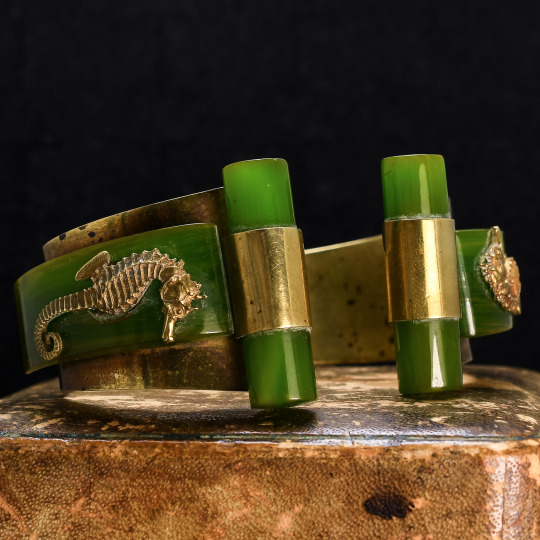
An especially cool Jean Painlevé bangle dating from the Art Deco period, circa 1935. Jean Painlevé, a French film maker with an interest in biology. Painlevé’s breakthrough came in 1935, with his film "L’Hippocampe" or The Seahorse. In the wave of his success, in 1936, Painlevé and his wife commissioned a range of seahorse jewellery. This piece, a yellow metal torque bangle, topped with bakelite and two gold coloured seahorses. It's not your typical shaped bangle, but is more oval shaped, with two "cylinders" of bakelite to slip your wrist through.

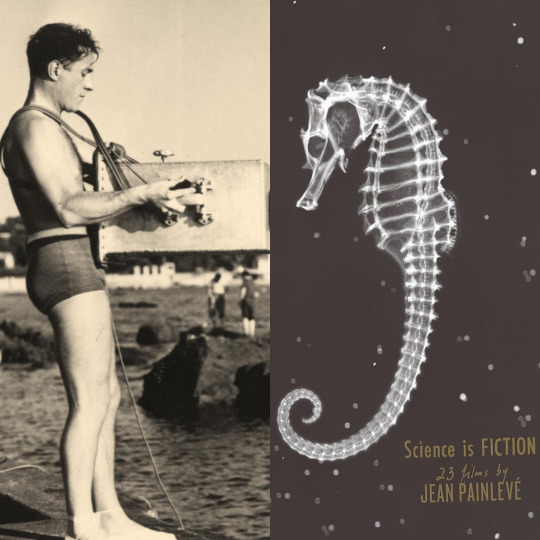
#antiquejewelry#antique jewelry#butterlaneantiques#fine jewelry#antiques#butter lane antiques#art deco#art deco jewelry#art deco style#art deco fashion#jean pain#jean painlevé#the seahorse
0 notes
Text
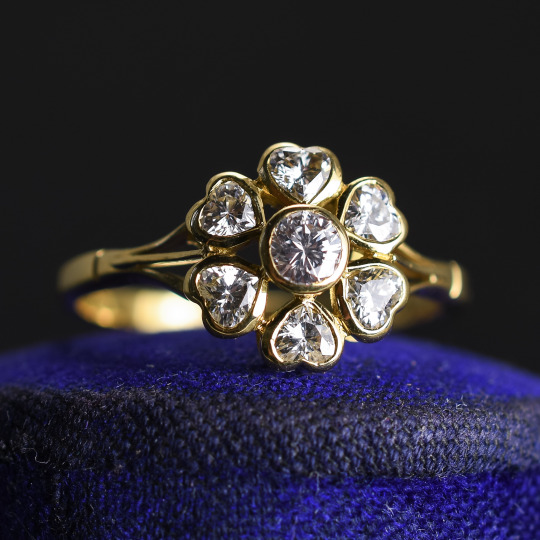
Hearts and diamonds are a match made in romantic heaven..
This charming Vintage cluster ring features gorgeous heart shaped diamonds and a brilliant cut diamond, arranged in a lovely flower cluster formation. It's crafted in 18k gold throughout with lovely split shoulders, and features English hallmarks dating it to 1987.
The lineage of the heart-shaped diamond stretches back over half a millennium! Its inaugural mention is attributed to Francesco Sforza, the Duke of Milan, in 1463, during an intriguing conversation. In this exchange, the Duke analogized the legendary exploits of the affluent "Cosimo de Medici" from the political dynasty in Florence to the allure of a heart-shaped diamond. If we entertain the veracity of this dialogue, it suggests that heart-shaped diamonds were fashioned prior to the 15th century and gained renown as emblems of regal status.
Following closely, in 1562, Mary Queen of Scots gifted to Queen Elizabeth a magnificent ring embellished with a heart-shaped diamond. This illustrious gem ranks among the most celebrated diamond hearts in history, imbued with connotations of camaraderie and benevolence during its era.
#antiquejewellery#antiquejewelry#antiquerings#antiqueclusterring#antiqueflowerring#antiquediamondring#antiquediamond#antiqueringsoftheday#ringsoftheday#ringsofinstagram#showmeyourrings#vintagejewelry#vintagejewellery#vintagerings#vintagestyle#vintagediamonds#vintagejewels#vintage#heartcutdiamonds#heartdiamonds#heartdiamondring#heartcutdiamondring#butterlaneantiques
4 notes
·
View notes
Text
19th Century Scottish "Pebble" Jewellery

Scotland is known for its abundance of coloured agate which is found in a huge variety of colours and patterns, each type specific to a particular locality. Lapiadaries working in Edinburgh's "new town" made most of the pebble jewellery produced in the 18th and 19th centuries, sourcing stones from collectors who scoured the country in search of new deposits. Queen Victoria's love for all things Scottish generated a buoyant demand for jewellery of this style, and it's estimated that the number of people working in jewellery manufacturing in the 1870s exceeded two thousand.


A superb antique pebble bracelet and brooch set made in Scotland in the latter half of the 19th century. It comprises a series of graduated discs, each one featuring a Cairngorm citrine that forms the top of a dome with triangular cut-out sections to create a star motif around it. The gold is finely engraved with abstract foliate detailing, and inlayed with colourful varieties of agate and hardstone, including jasper, Montrose agate, granite, and bloodstone.
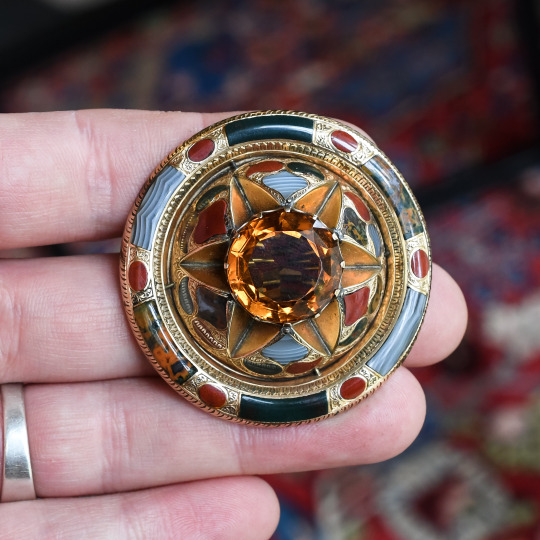
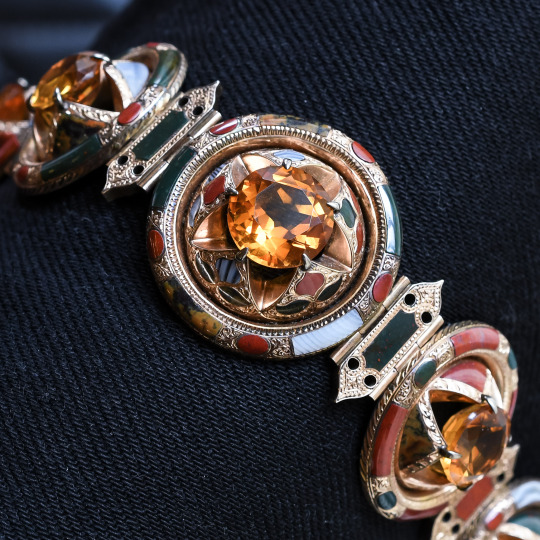
Further reading: Agates of Scotland
1 note
·
View note
Text

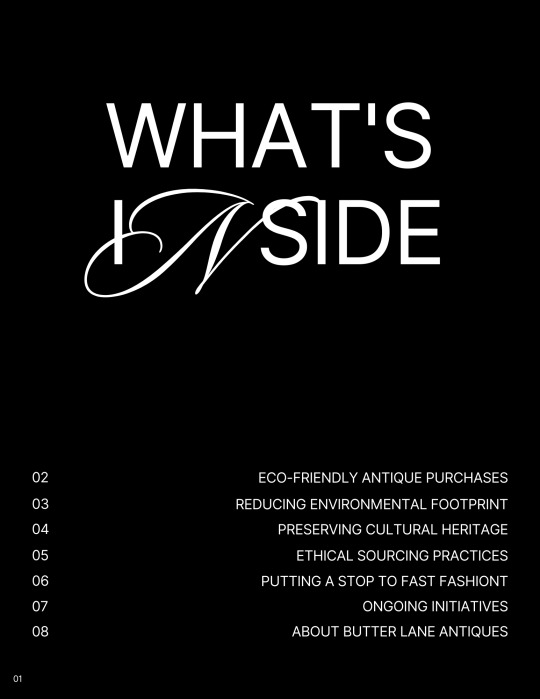
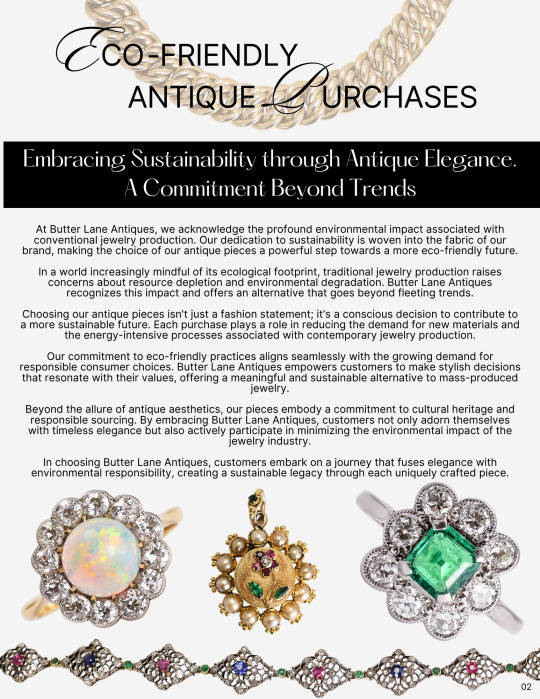


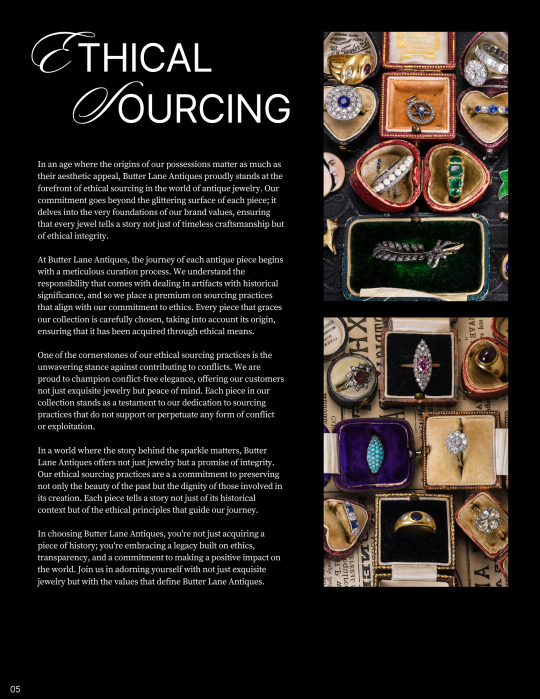
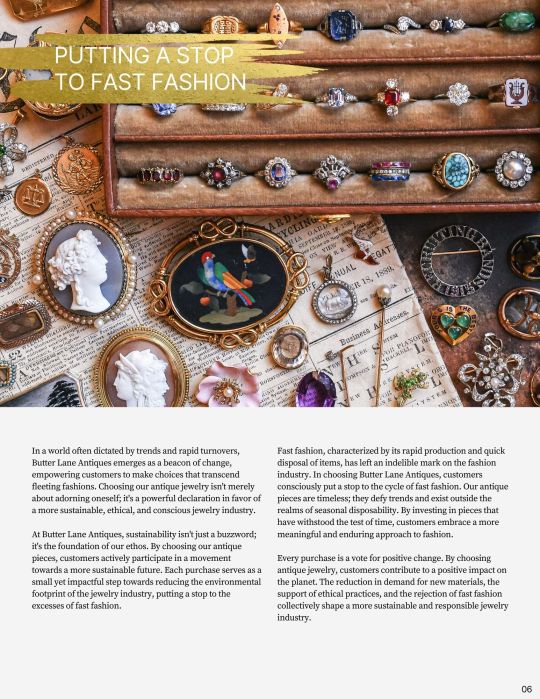



Adorning With Purpose - A Guide to Sustainable Jewellery
#SustainableJewelry#EthicalFashion#SlowFashion#GreenLiving#EcoFriendlyJewelry#EthicalSourcing#ArtisanCraftsmanship#RecycledMaterials#ConsciousConsumption#JewelryForChange#SustainableStyle#GreenFashion#EcoLuxury#ResponsibleProduction#ReduceReuseRecycle#EnvironmentalAwareness#EthicalDesign#JewelryWithPurpose#SustainableLiving#FashionRevolution#FairTradeJewelry
3 notes
·
View notes
Text

A Journey Through the Ages
In a world of fleeting trends, antique jewelry stands as a testament to enduring elegance. Join us on a journey through history, appreciating the craftsmanship that narrates tales of bygone eras.
Pre-Georgian (Pre 1714):
Jewelry has been a constant companion throughout history. From Ancient to Medieval times, precious gemstones adorned people, occasionally preserved underground for centuries. This period encompasses the grandeur of the Baroque style.
Georgian (1714 - 1830):
Spanning from the early 18th to the early 19th century, the Georgian era exudes grace and sentimentality amid social and political upheavals. Reserved for the aristocratic elite, Georgian jewelry features opulent gemstones like garnets, emeralds, and diamonds, with intricate metalwork and nature-inspired motifs capturing the essence of a romantic age.
Victorian (1837 - 1901):
The Victorian era, under Queen Victoria's reign, witnessed stability and prosperity. Departing from Georgian rationalism, Victorian jewelry embraced romantic ideologies, symbolizing everything from Hope to Death. As the middle class grew, increased disposable income and advanced production techniques made jewelry accessible to the masses.
Art Nouveau (1890 - 1915):
Reacting against Victorian industrialism, Art Nouveau, or "New Art," flourished from 1890 to 1920. Characterized by flowing curves and nature-inspired motifs, this movement brought a departure from large diamond pieces, focusing on vitreous enameling and unconventional gemstones. It aimed to distance itself from Victorian industrialism, making jewelry more accessible.
Edwardian Grace (1901 - 1910):
The Edwardian period, from King Edward VII's reign to 1920, radiates leisure and elegance. Departing from High Victorian ostentation, late 19th-century jewelry trends embraced smaller, more refined pieces. Technological advancements, especially in platinum usage, allowed intricate metalwork, defining the delicate elegance of the Edwardian era.
Art Deco (1920 - 1935):
Emerging before World War I, Art Deco blended modernist aesthetics with meticulous craftsmanship. Influenced by Cubism's geometric forms and the vibrant colors of the Ballet Russes, it broke down barriers between artists and craftsmen. Designers like Cartier and René Lalique shifted focus to colorful gemstones, employing millegrain and embracing futuristic geometric designs.
This journey through time illustrates the evolution of jewelry, where each era tells a unique story of societal changes, evolving aesthetics, and exquisite craftsmanship.
1 note
·
View note
Text
MEDUSA
Medusa is the best known of the three monstrous Gorgon sisters. Our earliest reference to the Gorgons is found in Hesiod's Theogony, but it was Ovid who really fleshed out the story - in the Metamorphoses - where he describes Medusa in her youth:
"Medusa once had charms; to gain her love
A rival crowd of envious lovers strove.
They, who have seen her, own, they ne'er did trace
More moving features in a sweeter face.
Yet above all, her length of hair, they own,
In golden ringlets wav'd, and graceful shone."
Her beauty caught the eye of Poseidon, who forced himself upon her in a shrine to Athena. Athena was furious; she turned Medusa's hair into snakes, and made her face so hideous that anyone who saw it was instantly turned to stone (literally petrified). In most versions of the story, Medusa was killed by Perseus who was given various items to help him on his quest: a mirrored shield from Athena, a sword forged by Hephaestus, and Hades's helm of invisibility. While looking at the reflection in the shield, Perseus was able to behead the Gorgon, at which point Pegasus flew out of her severed neck. He went on to use her head - which retained its petrifying effect - as a weapon, using it to transform the Titan Atlas into stone (where he still stands in North Africa as the Atlas Mountains), before eventually giving it to Athena.
Although Medusa is commonly regarded as a monster, her head has often been seen as a protective amulet to keep evil away. Indeed, the name Medusa comes from the ancient Greek word meaning "to guard or protect".
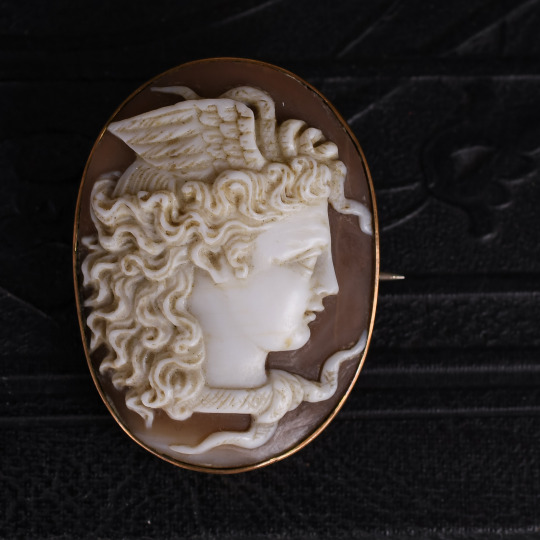
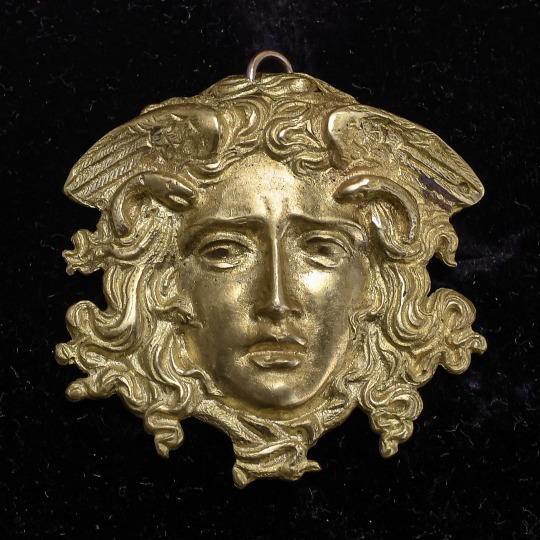
#medusa jewelry#antique jewelry#medusa head#mythology#mythology jewelry#antique brooch#brooches are back#butter lane antiques
9 notes
·
View notes
Text
LAPIS LAZULI

For centuries, Afghanistan has been an important source for top-quality lapis. Historians beleive the link between humans and lapis lazuli stretches back more than 6,500 years. The gem was treasured by the ancient civilizations of Mesopotamia, Egypt, China, Greece, and Rome.
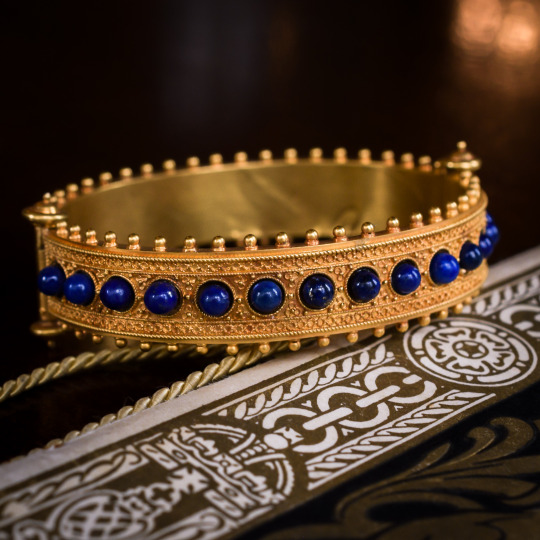

Lapis lazuli is a powerful stone for thinking and spirituality, and it has a very high vibration. It’s believed to increase self-knowledge and awareness of one’s own thoughts and can help you to trust your inner wisdom.
10 notes
·
View notes
Text
Georgian Doves And Love Knot 'LE PLUS LOIN LE PLUS SERRE' Intaglio Seal Fob
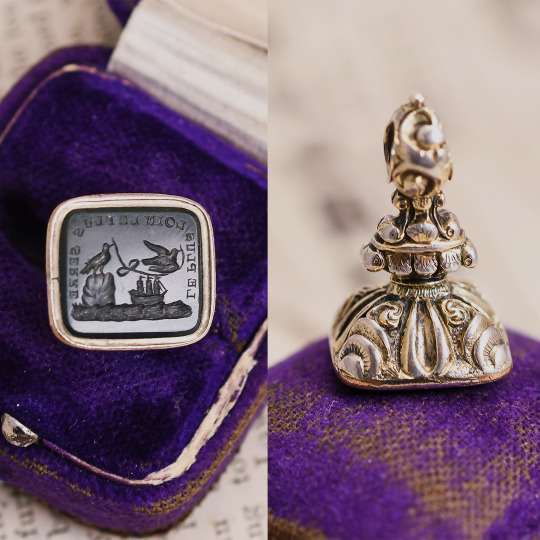
Charming antique seal fob pendant set with an intaglio carved bloodstone base depicting two doves and a love knot, along with the words LE PLUS LOIN LE PLUS SERRE. This translates to the furthest, the tightest, which in this case could symbolize the further away you are from a lover, the tighter your relationship becomes. A romantic piece for sure, which features a highly ornate body, crafted in 15 karat yellow gold. Circa 1780.
(source: butterlaneantiques.com)
#antique jewelry#antique pendant#antique fob#georgian jewelry#georgian fob#georgian style#19th century#butter lane antiques
1 note
·
View note
Text
The History of Spinel
Spinel is a good candidate for the title of “History’s Most Underappreciated Gem.” Ancient mines that supplied gems for royal courts from Rome to China produced spinel, but it was usually confused with stones like ruby and sapphire.
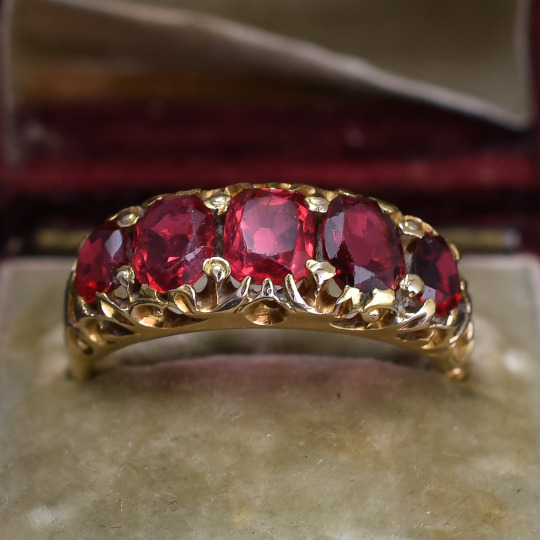
Late Victorian Red Spinel 5-Stone Carved Half-Hoop Ring - www.butterlaneantiques.com
One of the most famous examples is the so-called “Black Prince’s ruby.” This historic crimson-red gem is set in England’s Imperial State Crown and displayed in the Tower of London.
It first appeared in the historical records of fourteenth-century Spain, and was owned by a succession of Moorish and Spanish Kings before Edward, Prince of Wales—the “Black Prince”— received the stone in 1367 as payment for a battle victory.

Don Pedro died just three years later, and Edward died before inheriting the English throne. So, the gem passed to Edward's son, King Richard II, who was murdered when he was just 21 years old. The Black Prince's Ruby passed through the hands of several English rulers, who died under tragic circumstances, causing it to be cursed.
#royal jewels#english antique#royal family#royal family crown#royal crown#black princes ruby#spinel crown#ruby crown#red spinel#spinel jewelry#butter lane antiques
4 notes
·
View notes
Text
Belle Époque Garnet & White Paste Millegrain Tiara
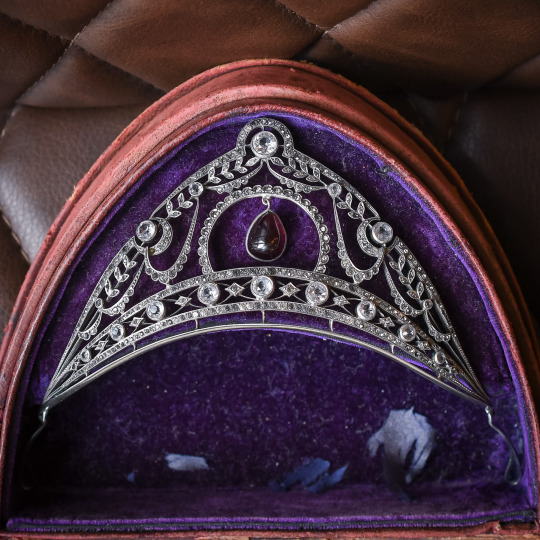
A stunning antique tiara dating from the Belle Époque era, circa 1910. It's studded with glistening white paste gemstones, finished in fine millegrain detailing, and set with a large, pear-shaped garnet cabochon drop at the centre. Offered in the original fitted presentation box.
(source: butterlaneantiques.com)


By brides wearing tiaras or crowns on their wedding day it was symbolic of the marriage and really a rite of passage. This custom was established by the beginning of the 16th Century in the UK. Only married women could wear tiaras and it represented the end of an innocent maidenhood and the start of married life.
(source: weddingplanner.co.uk)
#wedding tiara#wedding head band#bridal tiara#belle epoque#antique tiara#antique crown#french tiara#french jewelry#antique head wear#princess tiara#butter lane antiques
7 notes
·
View notes
Text
Art Deco Bloodstone "Griffin & Sword" Intaglio Signet Ring
Superb antique signet ring set with a 3D geometrical cut bloodstone head with intaglio carved heraldic crest depicting a griffin holding a sword. The bloodstone presents a deep green colour - almost black - with flecks of red throughout, and ideal contrast to the high-carat yellow gold mount. Intricate floral and foliate engraving adorns the gallery, and it dates from the 1920s. Handmade throughout with SS maker's mark inside the band. Crafted in 15 karat gold.
The crest belongs to Clan Bannatyne of Scotland, worn by all of the name and ancestry and often seen alongside their Latin motto: "Nec Cito Nec Tarde" (neither fast nor slow). In heraldry-speak it would be described as: "A demi-griffin, in his dexter paw a sword erect, Proper"

(source: butterlaneantiques.com)
#signetring#bloodstonejewelry#bloodstone#griffin and sword#antiquejewelry#antiques#art deco jewelry#art deco fashion#dark jewelry#old gold#intaglio ring#intaglio
7 notes
·
View notes
Text
Memorial Jewellery
Hair work jewellery originated in France and England in the 1700’s, evolving from the craft of wig makers. Initially, the jewellery functioned as a mourning memento and was a common funeral gift in the 18th century. Rings, brooches, necklaces, watch fobs, earrings and much more were crafted from the lock of a loved one.



Cool Regency period key pendant, circa 1810. There's a round locket compartment in the centre of the bow, currently home to a tightly woven lock of hair (the Georgians were like that..), and features intricate filigree ropework details along the shank and unusual (but quite lovely) hand-engraved detailing to the bit. As you can probably tell, I just googled "anatomy of a key" and it was somewhat illuminating - I would have only hit on one of those three descriptors. The significance of the key is clear here, not the usual "key to my heart", but rather it's a memorial piece, so the key unlocks a memory of the deceased. Crafted in 15 karat gold, converted from a brooch.
(Source: butterlaneantiques.com)
#memorial jewelry#hair jewelry#memorial#victorian era#georgian era#georgian style#antiques#antiquejewelry#memorial art#butterlaneantiques
4 notes
·
View notes
Text
Opal Stone
Opals have been compared to fireworks, galaxies and even volcanoes. With their beautiful array of colours, I can see why. In Ancient Rome, it was given the name 'Opalus' , meaning 'precious stone'. Opals were seen to be more rare than diamonds or rubies due to their flashes of light and colour, as they were known to be the stone of myths and dreams.
Many different cultures believed the stone brought power, luck and health and even today, this belief still remains.

Stunning antique opal five-stone ring dating from the early 20th century, circa 1910. The stones are bright and lively with excellent play-of-colour that appears to dance as it moves in the light - the full rainbow colour spectrum on display. It's crafted in 18 karat gold with fine claw settings and a fluted gallery.
(source: butterlaneantiques.com)
So what does it mean if someone gifts you an opal ?
Because of stone's connection with the star sign Libra, it is often related to feelings of passion, love and desire.
#opalring#opalstone#opaljewelry#edwardianjewelry#edwardian#edwardian era#jewelry for women#butterlaneantiques
3 notes
·
View notes
Text
MEDUSA

(Source: butterlaneantiques)
Medusa is the best known of the three monstrous Gorgon sisters. Our earliest reference to the Gorgons is found in Hesiod's Theogony, but it was Ovid who really fleshed out the story - in the Metamorphoses - where he describes Medusa in her youth:
"Medusa once had charms; to gain her love
A rival crowd of envious lovers strove.
They, who have seen her, own, they ne'er did trace
More moving features in a sweeter face.
Yet above all, her length of hair, they own,
In golden ringlets wav'd, and graceful shone."
Her beauty caught the eye of Poseidon, who forced himself upon her in a shrine to Athena. Athena was furious; she turned Medusa's hair into snakes, and made her face so hideous that anyone who saw it was instantly turned to stone (literally petrified). In most versions of the story, Medusa was killed by Perseus who was given various items to help him on his quest: a mirrored shield from Athena, a sword forged by Hephaestus, and Hades's helm of invisibility. While looking at the reflection in the shield, Perseus was able to behead the Gorgon, at which point Pegasus flew out of her severed neck. He went on to use her head - which retained its petrifying effect - as a weapon, using it to transform the Titan Atlas into stone (where he still stands in North Africa as the Atlas Mountains), before eventually giving it to Athena.
Although Medusa is commonly regarded as a monster, her head has often been seen as a protective amulet to keep evil away. Indeed, the name Medusa comes from the ancient Greek word meaning "to guard or protect".
#medusa#mythology#roman mythology#serpent#myth#gorgon#victorian era#victorian jewelry#antique jewelry#antique brooch#medusa jewelry#mythology jewelry#butter lane antiques
1 note
·
View note
Text
Regency Period Dendritic Agate Butterfly Brooch
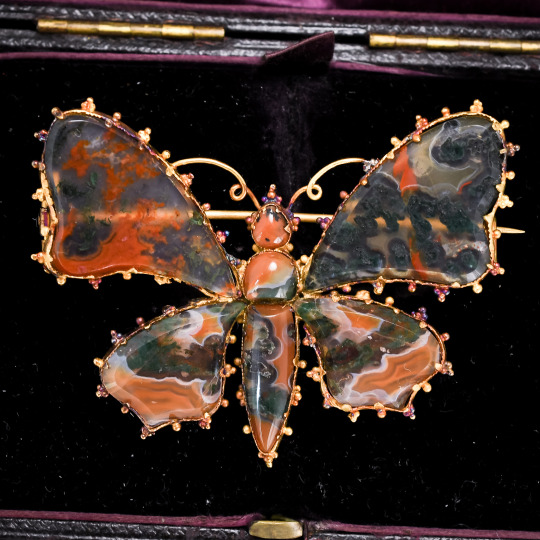
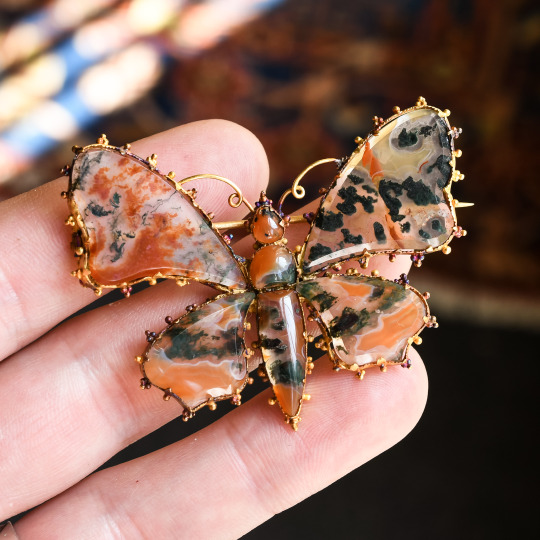
A magnificent antique butterfly brooch dating from the Georgian Regency Period, circa 1810. The wings are set with attractive dendritic agate panels flecked with red, green, and orange; beautifully hand cut to form the fore and hind wings, and body sections. They're mounted in 15 karat gold embellished with alternating triple and single pommel details as well as looped antennae. Exceptionally finely made, and a good large size at 6.1cm width.
(source: butterlaneantiques)
1 note
·
View note
Text
VICTORIAN LANGUAGE OF FLOWERS
Floriography is the 'language of flowers' and has been practised for thousands of years across different cultures. It was popularised in Britain during the Victorian era when learning the symbolism behind each flower became a popular hobby.
(source: https://www.museumselection.co.uk/victorian-language-of-flowers)

Stunning antique locket dating from the mid Victorian period, circa 1870. The front features a breathtaking pastoral scene, with goldfinch and dragonfly swooping through the air above bluebells and wild (dog) roses - all intricately rendered in fine enamel. Victorian jewellery often includes floral motifs, as part of their "Language of Flowers", whereby each flower or plant represented some romantic or emotional sentiment... in this case, the bluebells for humility, and the pink dog rose for grace and joy. Further to the floral symbolism (and testament to just how much the Victorians loved attaching symbolic meaning to things) the dragonfly represents change and transformations in life and new beginnings, specifically embracing change without fear, and the goldfinch for joy, enthusiasm, positivity, and persistence. So the distilled sentiments this locket represents, in rough order of emphasis: joy in new beginnings, enthusiastically accepted with grace and humility.
(source: butterlaneantiques.com)
Here are some examples of the language of flowers.

#victorian history#victorian era#victorianjewelry#victorian flower language#flower language#victorian style#flower jewelry#butter lane antiques
16 notes
·
View notes